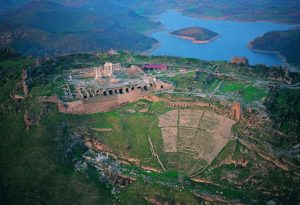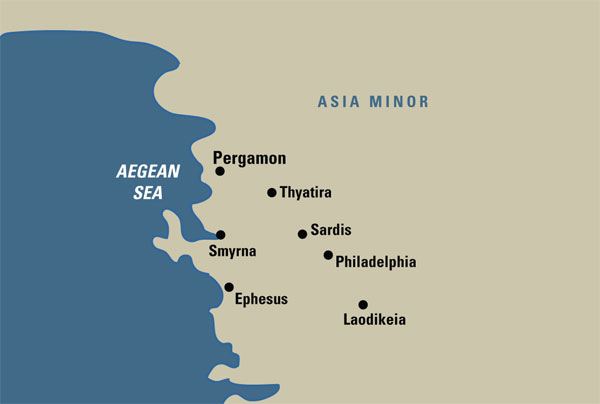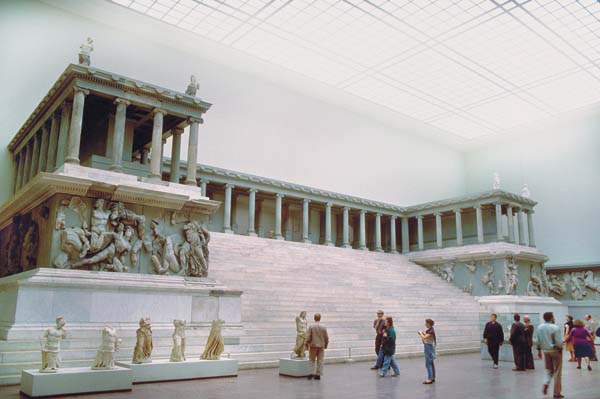
Pergamon’s strategic location along both land and sea trading routes contributed to its prosperity. Pilgrims from all over the Mediterranean region would flock to the city to engage in commerce or to visit the famous Ascelpion, a center of medical treatments.
Perched atop a windswept mountain along the Turkish coastline and gazing proudly—almost defiantly—over the azure Aegean Sea sit the ruins of ancient Pergamon. Although the majority of its superb intact monuments now sit in Berlin’s Pergamon Museum, enough remains of the acropolis for the visitor to sense the former greatness of the city that once rivaled Alexandria, Ephesus and Antioch in culture and commerce, and whose scientific advancements in the field of medicine resonate through the corridors of today’s medical treatment facilities. Juxtaposed sharply against this image of enlightened learning is that of “Satan’s Throne,” as described by the prophet John of Patmos (Revelation 2:12–13), which some scholars interpret as referring to the Great Altar of Pergamon, one of the most magnificent surviving structures from the Greco-Roman world.1
The modern visitor approaches the site from the steep and winding road that leads from the modern Turkish city of Bergama just a few miles away. Upon reaching the ruins, the commanding panoramic view from Pergamon’s 1,000-foot-high perch makes it easy to understand how this city once dominated the entire region. It was a proud city in its time, and it had reason to be so. Its monuments and building were constructed of high-quality white marble in the finest Hellenistic style, and its library rivaled that of the famed library of Alexandria in Egypt. In the mid-second century A.D., it became known throughout the Mediterranean world as a center of ancient medicine, largely due to the presence of the eminent Roman physician Galen (c. 129–200 A.D.), who was born in ancient Pergamon.
In the free eBook Paul: Jewish Law and Early Christianity, learn about the cultural contexts for the theology of Paul and how Jewish traditions and law extended into early Christianity through Paul’s dual roles as a Christian missionary and a Pharisee.
Pergamon rose to prominence during the years of the Greek empire’s division following the death of Alexander the Great in 323 B.C. His short-lived empire was partitioned among his generals, with General Lysimachus inheriting the then-settlement of Pergamon and its wealth. Due largely to its strategic position along land and sea trading routes and in part to the wealth of the Attalid kings who ruled the kingdom, the city enjoyed centuries of prosperity that continued when it passed peacefully to Rome’s control in 133 B.C. From that point on, Pergamon’s fate was inextricably linked to that of Rome, and it rose and fell in tandem with the great Roman Empire.

Pergamon’s strategic location along both land and sea trading routes contributed to its prosperity. Pilgrims from all over the Mediterranean region would flock to the city to engage in commerce or to visit the famous Ascelpion, a center of medical treatments.
The oldest and arguably most beautiful section of Pergamon is also its highest. The acropolis of Pergamon rises triumphantly over the ruins of the city that cascades down the steep slopes to the valley below. One of the most dramatic structures of the acropolis was what scholars believe to be the Temple of Zeus, the massive foundations of which are all that remain on the southern slope of the site. The altar believed to be associated with the temple, known today as the Great Altar of Pergamon, was moved to Berlin in the 19th century by German archaeologists, who evidently had an easy time getting permission for its removal from the indifferent authorities of the Ottoman empire.
Walking north from the Temple of Zeus and site of the Great Altar of Pergamon, one encounters the remains of the Temple of Athena, constructed at the end of the fourth century or beginning of the third century B.C., and dedicated to the city’s patron goddess. Just beyond that to the northwest is the magnificent structure that was the city’s famous library. While the estimated 200,000 documents of both papyrus and parchment may be rather high (Seneca estimates that approximately 40,000 volumes were catalogued in the larger library of Alexandria), it was certainly one of the largest collections of written material in the ancient world and was famous throughout the Mediterranean. It also housed one of the most extravagant wedding gifts of all time: Mark Antony is said to have presented Cleopatra with a sizable portion of the Pergamon library’s collection, in part to restore Alexandria’s own collection that went up in flames during Julius Caesar’s occupation of the city.

The Great Altar of Pergamon is considered to be one of the greatest surviving monuments from antiquity. Now located in the Pergamon Museum in Berlin, Germany, the altar is thought by many scholars to be the “throne of Satan,” referred to by the prophet John in the Book of Revelations. (Revelation 2:12–13)
The best-preserved ancient sacred structure on ancient Pergamon’s acropolis is the Temple of Trajan, built during the reign of Emperor Hadrian (117–138 A.D.) and dedicated to his deified predecessor. Towering imposingly over the surrounding structures and ruins, its commanding presence is a testament to the strength of the imperial cult.
Read “Who Is Satan?” and “How the Serpent Became Satan” in Bible History Daily.

The Temple of Trajan, or the Trajaneum. The towering structure attests to the strength of the imperial cult in the city. After Augustus became the first emperor of the Roman Empire, Pergamon was authorized to become the first imperial cult center in the east.
It is hard to imagine, gazing up at its enormous height, that this was actually one of the smaller sacred structures in the temple precinct of the acropolis. The sheer size and majesty of the building against the dramatic backdrop of the valley below and the ocean and sky beyond is truly awe-inspiring.
Every ancient Greek city worth its name boasted a theater. A place for both entertainment and civic gatherings, the theater was a focal point of public life in the Greco-Roman world. The architecture of the nearly intact theater of Pergamon not only attests to the city’s importance but also provides what is surely one of the most spectacular—and dizzying—settings of the ancient world. Cascading sharply down the precipitous slope of the acropolis toward the sea, the theater is one of the steepest of its kind. The 10,000 visitors would have had to carefully navigate the 80 rows of horizontal seating, lest they take a fatal tumble to the stage more than 120 vertical feet below. Like many ancient Greek theaters, the theater at Pergamon is an acoustic marvel: An actor (or tourist) speaking normally on the stage can be heard even at the top of the cavea (seating structure).
During the second century A.D., Pergamon’s fame as a center of healing and medical science eclipsed its reputation for anything else. Its most celebrated citizen during this period was the physician Galen, whose work and research was largely responsible for providing the foundation from which modern western medicine was to spring. The asclepion at ancient Pergamon was one of the most famous in the ancient world, and this ancient version of a medical spa attracted pilgrims from all over the Mediterranean region who came seeking the restorative powers of its thermal waters and medical treatments for various ailments and injuries.
Given the fact that they city represented the epitome of Hellenistic culture, traditions and religion in both its pursuits and its very architecture, it is perhaps not surprising that early Christians viewed it as a bastion of all that was anathematic to Christian beliefs. In the Book of Revelation, John conveys a message from the risen Christ to seven Christian congregations in Asia Minor, all of which are located in modern Turkey. Pergamon’s congregation was one of these, and Christ’s message to the faithful praises them for adhering to their faith while living in the place “where Satan dwells.” Antipas, a Christian bishop of Pergamon, was believed to have been martyred here at the end of the first century A.D., around the time when many scholars believe the Book of Revelation was composed. The execution of their bishop certainly would not have endeared the city to its Christian inhabitants, and the Biblical reference to the city is reflective of the general tension between Christian and pagan communities at the end of the first century A.D.

Overcoming vertigo, the author stands in the middle tier of the three-tiered theater of Pergamon, the steepest known theater from the Greco-Roman world.
As part of the Roman Empire, Pergamon’s decline mirrored that of the empire as a whole. Like the rest of the region, it eventually came under Byzantine and then Ottoman rule. By the late 19th century, excavations had begun at the ancient site, and today it draws people from all over the world. Climbing up to the peak of the acropolis, the modern visitor can easily sense the echo of Pergamon’s glorious past, which can still be heard among the beauty of its marble ruins today.
Notes:
1. See Adela Yarbro Colins, “Satan’s Throne,” BAR, May/June 2006.
 Sarah Yeomans is an archaeologist specializing in the Imperial period of the Roman Empire with a particular emphasis on ancient science and religion. Currently pursuing her doctorate at the University of Southern California, she also consults as Director of Educational Programs at the Biblical Archaeology Society and is adjunct faculty at both St. Mary’s College of Maryland and West Virginia University. A native Californian, Sarah holds a M.A. in archaeology from the University of Sheffield, England, and a M.A. in art history from the University of Southern California. She has conducted archaeological fieldwork in Israel, Italy, Turkey, France, and England and has worked on several television and film productions, most recently as an interviewed expert on The Story of God with Morgan Freeman. She is a Provost Fellow at the University of Southern California and is the recipient of a Research Fellowship from the American Research Institute of Turkey (ARIT) as well as a Mayers Fellowship at the Huntington Library and Museum in Los Angeles. Her current research involves ancient Roman medical technology and cult, as well as the impact of epidemics on Roman society. She is generally happiest when covered in dirt, roaming archaeological sites somewhere in the Mediterranean region.
Sarah Yeomans is an archaeologist specializing in the Imperial period of the Roman Empire with a particular emphasis on ancient science and religion. Currently pursuing her doctorate at the University of Southern California, she also consults as Director of Educational Programs at the Biblical Archaeology Society and is adjunct faculty at both St. Mary’s College of Maryland and West Virginia University. A native Californian, Sarah holds a M.A. in archaeology from the University of Sheffield, England, and a M.A. in art history from the University of Southern California. She has conducted archaeological fieldwork in Israel, Italy, Turkey, France, and England and has worked on several television and film productions, most recently as an interviewed expert on The Story of God with Morgan Freeman. She is a Provost Fellow at the University of Southern California and is the recipient of a Research Fellowship from the American Research Institute of Turkey (ARIT) as well as a Mayers Fellowship at the Huntington Library and Museum in Los Angeles. Her current research involves ancient Roman medical technology and cult, as well as the impact of epidemics on Roman society. She is generally happiest when covered in dirt, roaming archaeological sites somewhere in the Mediterranean region.
This Bible History Daily article was originally published on July 16, 2013.
Become a member of Biblical Archaeology Society, and gain All Access with your membership today
The BAS Library includes online access to more than 9,000 articles by world-renowned experts and 22,000 gorgeous color photos from…
- more than 45 years of Biblical Archaeology Review
- 20 years of Bible Review, critical interpretations of Biblical texts
- 8 years of Archaeology Odyssey, exploring the ancient roots of the Western world
- The fully-searchable New Encyclopedia of Archaeological Excavations in the Holy Land, an authoritative work of the past century of archaeological study
- Video lectures from world-renowned experts
- Four books published by BAS and the Smithsonian Institution
Plus, you get access to so much more from your All-Access pass:
Biblical Archaeology Review print edition:
Enjoy our current issues in the convenient, time-tested, paper magazine format…
- One year of print issues of Biblical Archaeology Review magazine
Biblical Archaeology Review digital edition:
Stay on top of the latest research! You get …
- One year of issues of Biblical Archaeology Review magazine, all on your iPhone, iPad, Android, or Kindle Fire
- Instant access to the complete digital edition back-issue catalog of BAR from the January/February 2011 issue forward
All of this rich and detailed scholarship is available to you—right now—by becoming an All-Access member.
That’s right: when you join as an All-Access member, you get a ticket to four decades of study, insight and discovery. Why not join us right now and start your own exploration?
Whether you’re researching a paper, preparing a sermon, deepening your understanding of Scripture or history, or simply marveling at the complexity of the Bible – the most important book in history—the BAS All-Access pass is an invaluable tool that cannot be matched anywhere else.
You'll get to experience all the discoveries and debate in beautiful clarity with Biblical Archaeology Review, anytime, anywhere! And the Library is fully searchable by topic, author, title and keyword, and includes curated special collections on topics of particular interest.
The All-Access membership pass is the way to explore Bible history and biblical archaeology.
The post Ancient Pergamon appeared first on Biblical Archaeology Society.


0 Commentaires